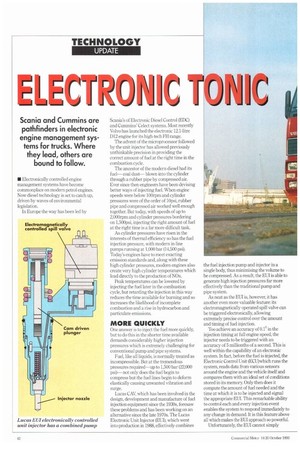Eli) I 10 1 C Scania and Cummins are pathfinders
Page 44

Page 45

If you've noticed an error in this article please click here to report it so we can fix it.
in electronic engine management systems for trucks. Where they lead, others are bound to follow.
• Electronically controlled engine management systems have become commonplace on modern petrol engines. Now diesel technology is set to catch up, driven by waves of environmental legislation.
In Europe the way has been led by Scania's of Electronic Diesel Control (EDC) and Cummins' Celect systems. Most recently Volvo has launched the electronic 12.1-litre D12 engine for its high-tech FH range.
The advent of the microprocessor followed by the unit injector has allowed previously unthinkable precision in providing the correct amount of fuel at the right time in the combustion cycle.
The ancestor of the modern diesel had its fuel— coal dust— blown into the cylinder through a rubber pipe by compressed air. Ever since then engineers have been devising better ways of injecting fuel. When engine speeds were below 100rpm and cylinder pressures were of the order of lOpsi, rubber pipe and compressed air worked well enough together. But today, with speeds of up to 2,000rpm and cylinder pressures bordering on 1,500psi, injecting the right amount of fuel at the right time is a far more difficult task.
As cylinder pressures have risen in the interests of thermal efficiency so has the fuel injection pressure, with modern in-line pumps running at 1,000 bar (14,500 psi). Today's engines have to meet exacting emission standards and, along with these high cylinder pressures, modern engines also create very high cylinder temperatures which lead directly to the production of NOx.
Peak temperatures can be lowered by injecting the fuel later in the combustion cycle, but retarding the injection in this way reduces the time available for burning and so increases the likelihood of incomplete combustion and a rise in hydrocarbon and particulate emissions.
MORE QUICKLY
One answer is to inject the fuel more quickly, but to do this in the shorter time available demands considerably higher injection pressures which is extremely challenging for conventional pump and pipe systems.
Fuel, like all liquids, is normally treated as incompressible. But at the tremendous pressures required—up to 1,500 bar (22,000 psi)— not only does the fuel begin to compress but the fuel lines begin to deform elastically causing unwanted vibration and surge.
Lucas CAV, which has been involved in the design, development and manufacture of fuel injection equipment since the 1930s, foresaw these problems and has been working on an alternative since the late 1970s. The Lucas Electronic Unit Injector (EUI), which went into production in 1988, effectively combines the fuel injection pump and injector in a single body, thus minimising the volume to be compressed. As a result, the EUI is able to generate high injection pressures far more effectively than the traditional pump and pipe system.
As neat as the EUI is, however, it has another even more valuable feature: its electromagnetically operated spill valve can be triggered electronically, allowing extremely precise control over the amount and timing of fuel injection. Too achieve an accuracy of 0.10 in the injection timing at full engine speed, the injector needs to be triggered with an accuracy of 5 millionths of a second. This is well within the capability of an electronic system. In fact, before the fuel is injected, the Electronic Control Unit (ECU)which runs the system, reads data from various sensors around the engine and the vehicle itself and compares them with an ideal set of conditions stored in its memory. Only then does it compute the amount of fuel needed and the time at which it is to be injected and signal the appropriate EUI. This remarkable ability to control each and every injection event enables the system to respond immediately to any change in demand. It is this feature above all which makes the EUI approach so powerful.
Unfortunately, the EUI cannot simply replace the conventional injector. Any engine manufacturer who wants to switch to EUI technology will need to design a new head, if not a complete engine. The loads involved in operating the injector plungers are very high and demand considerable stiffness in the head and cam drive train. The EUI plungers are actuated by an engine driven camshaft and, although it is possible to achieve the necessary stiffness using a pushrod and rocker arrangement, the closer the camshaft can be positioned to the plunger the better the control obtained.
Research by Lucas and Ricardo also suggests that for the optimum compromise between fuel economy and emissions the injector should be mounted centrally in the piston bore.
Volvo has followed this route: the new D12 has a one-piece head for maximum rigidity and an overhead camshaft to operate the EUI plungers which are ideally located on the centre line of the cylinder bores.
HIGH DEGREE
Having invested heavily in this new technology Volvo can claim a number of advantages over conventional systems. For example, the programmed fuelling maps in the ECU's memory can deliver a high degree of torque shaping and a variety of predetermined regimes such as all speed and maximum road speed governors.
For the future the ECU can also cope with two-stage injection which provides even better emission control and can be programmed to cut out cylinders at idling speed, further reducing emissions. The cutout cylinder would be changed on each cycle to reduce engine wear and to maintain an
even temperature across the engine.
Three main sensors govern the injector settings. The first reads accelerator pedal position to determine driver demand; the crankshaft sensor monitors engine speed for information on timing and fuelling; and a camshaft sensor monitors the injection distribution sequence. An enginetemperature sensor provides information for the temperature compensation programme and helps control the cold start routine. Another sensor measures turbocharger boost pressure and allows the ECU to modulate the fuelling accordingly during acceleration.
With this electronic engine control in place it is relatively easy to integrate it with other electronic features such as Volvo's Geartronic automatic transmission. With such a sophisticated interface between engine and transmission, changes become almost undetectable. In any case, engine control is so precise that any driver demand results in a smooth, progressive response, unbeatable driveability and best possible fuel economy.
Electronic engine management systems such as Cummins Celect and the Lucas EUI used on Volvo's D12 point the way to the future. As drivers experience full electronic control its popularity will grow and other manufacturers will follow their lead.
by Gibb Grace




















































































